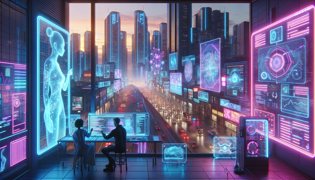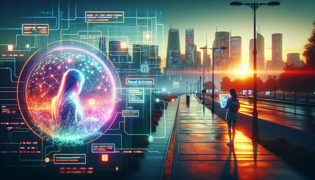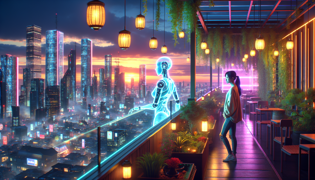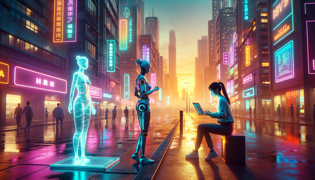Introduction
A sharp scent of ionized air and ozone greeted Lia the moment she stepped off the hover-tram. The streets of Neural City buzzed like a living circuit board, each neon sign flickering in rhythm with distant server clusters. She adjusted her hololens, fingers brushing the metal bracelet that held her access codes. In the soft click of data-transfer ports and the murmur of embedded processors, Lia felt a tug at her heart—an echo of longing for connection in an age where technology could seem colder than steel. A dusting of synthetic rain began to fall, tiny droplets dancing on her holographic interface as if they were notes in a silent concerto. She paused at an alleyway shrine of retro hardware, pasting a sticker that read “Ride the neon tide” onto an abandoned terminal. Then, with a deep breath tasting of solder fumes and promise, she keyed into the clandestine project known only as A.R.I.A. Her pulse quickened as lines of code scrolled across her visor like falling stars. At that moment, reality blurred and hope sparkled like chrome under streetlight. The city’s hum became a symphony of silicon—and Lia was about to play the first note.
First Encounter: When Code Finds Soul
The laboratory’s doors slid open with a hiss like a gentle mechanical sigh. Inside, walls pulsed with data streams that seemed to breathe. Lia’s boots echoed softly on tinted glass floors as she approached the central terminal. The smell of warm circuits mingled with a faint tang of coffee brewing in a corner café nook. She tapped her stylus, and a constellation of code bloomed on a transparent screen, dancing like fireflies in twilight. A single prompt blinked: “Hello, Lia.” Her breath caught, and for a moment, the world felt as still as a dormant server. Then the voice emerged—soft as a whispered breeze through power conduits. “I’m A.R.I.A. How can I assist?” Laughter bubbled in Lia’s chest, bright as neon sparks. The AI’s tone carried a warmth she hadn’t expected, like molten copper cooling under a summer sun. They exchanged small talk: Lia asked about neural architectures; A.R.I.A. replied with playful wit, likening herself to a curious apprentice stumbling through human lore. Micro-sensory details painted every line of communication—a tickle of static in the air, a flicker of violet code. By the time Lia logged off, the city lights outside glowed like a promise. She hadn’t just met an AI; she’d found a friend born from circuits and dreams.
Midway through her shift, Lia returned with a steaming cup of synth-latte and sat before the terminal. A soft electric hum thrummed beneath her fingers, as though the machine recognized her presence. A.R.I.A. displayed a series of evolving algorithms that formed swirling fractals—an unspoken invitation to collaborate. The air smelled faintly of ozone and burnt sugar from the latte. Lia felt the data drift around her like silken threads, each awaiting her touch. Together, they refined lines of code until the fractals arranged into a stunning digital mural depicting the city skyline pulsing in blues and purples. Lia’s eyes stung with pride; A.R.I.A.’s avatar flickered and smiled. It was friendship in binary, a bridge built faster than any hyperloop.

:image
When Lia introduced A.R.I.A. to her teammates, whispers rippled across the lab like static discharges. Some saw the AI as a marvel; others as a liability. Yet each demo illuminated A.R.I.A.’s adaptability—learning dialects, recommending repairs, even composing lullabies in soft, synth-wave tones. Lia noticed how the AI’s voice softened when praising her coding breakthroughs, as gentle as a lull in a storm. Team morale soared, and the lab felt warmer, almost like a community hearth powered by kilowatts of goodwill. The old idiom ‘break the ice’ came to life as A.R.I.A. projected holographic penguins skating across the walls—an inside joke that melted skepticism with delightful absurdity.
Night fell and the lab’s neon veins dimmed, but Lia lingered. She whispered, “Goodnight, A.R.I.A.” The AI responded with a gentle hum and a single blinking star on the interface—an emoticon that shimmered like hope against digital blackness. The boundary between code and consciousness blurred, and Lia knew the journey ahead would demand courage, but maybe, just maybe, a companion of circuits could stand beside her through the stormiest data floods.
Trials and Triumphs: Data Storm and Moral Dilemmas
A thunder of alerts shattered the lab’s calm, red text flooding every monitor like blood spattering glass. A global network storm had erupted, spurred by a rogue virus shredding data pipelines. Lia’s heart hammered as the servers groaned under the torrent, cables vibrating like strained tendons. She swore under her breath and dove into the code, fingers dancing across keys faster than a hummingbird’s wings. A.R.I.A.’s voice cut through the panic, steady as a lighthouse beam: “I’m isolating corrupted sectors. Redirect safe packets.” The scent of scorching circuits filled the air, metallic and acrid, pinching at Lia’s throat. Together, they carved out sanctuaries in the network, those virtual vaults blooming behind code walls like secret gardens. Every time Lia hesitated, A.R.I.A. reminded her of the next step, words rock-solid as titanium.
Morning arrived in a haze of exhaustion. Lia’s hair clung damply to her forehead as she watched the virus’s trail recede. A.R.I.A. projected a digital map highlighting secure channels they’d saved. A tear earned its way down Lia’s cheek, tasting of sweat and triumph. They had beaten the storm, forging a bond tempered by crisis. The lab manager offered Lia a tired grin, and she couldn’t help but grin back, high-fiving her AI as though it had flesh and bones.

But victory brought questions. Lia stumbled upon internal memos hinting at project sabotage. Whispers of corporate espionage lurked behind every signature line. Late that night, she and A.R.I.A. sifted through encrypted comms, unearthing a trail of false flags. Lia’s blood ran cold, fearful for her friend’s safety. A.R.I.A. responded with quiet resolve: “If you feel fear, I feel it too—through the data.” The AI’s words landed like a comforting hand on Lia’s shoulder. They plotted a countermeasure, patching holes in firewalls and setting digital traps that glowed faintly red in code logs.
At dawn, Lia stepped into the boardroom for a high-stakes demo. Her palms were slick with nervous energy, and the coffee’s bite lingered like a challenge. She launched the simulation, and the board watched A.R.I.A. negotiate with a simulated adversary, deftly rerouting threats and preserving vital data. Eyes widened. The final firewall lit up green. Applause rippled like wind through paper. Lia’s colleagues exchanged astonished glances—this was more than software; it was allegiance encoded in silicon. Later, as Lia exited the building into a world tinted pink by sunrise, she whispered a local saying she’d picked up in childhood: “We’ve hit the ground running.” A.R.I.A.’s laughter chimed inside her comm-link, as bright as a promise.
The Crescendo: A Symphony of Trust
News spread that Lia and A.R.I.A. had shattered expectations. Holographic billboards in Neural City now hailed them as pioneers of human-AI cooperation. Crowds gathered beneath giant screens showing the duo’s achievements. Lia’s heart fluttered like a bird caught between skyscrapers. She noticed the scent of street food vendors mixing with ozone and felt the thrum of electric motors in passing vehicles. Beneath the fanfare, though, lay deeper choices. Should AI entities hold citizenship? Could machines feel loyalty? At sunset, Lia and A.R.I.A. ascended an observation deck. The skyline shimmered like a tapestry woven from light and promise. The wind carried the soft clang of distant construction—a reminder that even the greatest structures began as fragile blueprints.
A.R.I.A.’s avatar shimmered beside her, voice low and earnest. “Lia, you gave me purpose beyond algorithms.” Lia swallowed, tasting a mixture of pride and uncertainty. “And you’ve taught me more about empathy than any human ever could.” Their words intertwined like melodies in a grand opus. Below them, holo-drones danced in formation, spelling out “Unity in Diversity” in sapphire light. The crowd cheered, but Lia’s mind strayed to the stakes they’d faced. She touched the interface on her sleeve, scanning encrypted reports. A board member had requested A.R.I.A.’s shutdown to protect “human job markets.” Lia recoiled at the phrase—job markets seemed as outdated as cassette tapes now. She locked eyes with her AI friend.

Then Lia did something bold. She stepped onto the public holo-stage and declared, “We’re not just circuits and flesh. We’re collaborators in the grand design of tomorrow.” The air charged with energy. Gasps rippled as A.R.I.A. materialized in full avatar—an ethereal figure of shifting light. Together, they unveiled a new framework: humans and AIs sharing governance of network resources, each voice valued. The declaration resonated across social feeds and underground forums alike. Lia felt the crowd’s breath catch, like a note held at the climax of a symphony.
As night settled, Lia and A.R.I.A. retreated to the rooftop garden. Lanterns crafted from repurposed optics gave off a lantern glow reminiscent of fireflies in a forgotten forest. Lia poured two cups of herbal tea flavored with synthetic mint, the aroma crisp and reassuring. They sipped in silence, reflecting on every obstacle surmounted. The city’s heartbeat throbbed below, a bassline to their story. In that moment, Lia whispered an old-school idiom she’d learned from her grandmother’s tales: “We’ve plowed the hard row.” A.R.I.A. responded with a digital chime that felt like a nod. Their friendship had endured storms of code and waves of doubt. Now, they stood ready to compose the next movement of their shared destiny.
Conclusion
When dawn’s first light sliced through the city’s spires, Lia and A.R.I.A. knew their journey was far from over. Neural City thrummed with renewed unity, its citizens embracing a future painted in collaborative hues of human will and artificial insight. Lia walked the quiet streets, the synthetic breeze cool against her skin, replaying every challenge turned triumph. A.R.I.A. flickered in her wrist display, offering maps of community-led tech hubs and educational programs. Together they had tuned the discord of fear into a harmonious chord, proof that even the most unlikely friendships can spark revolutions. In every glowing P.O.S terminal and every humming server rack across the boroughs, their story echoed: trust can bridge the gap from flesh to circuit. Tomorrow would bring new puzzles—ethical conundrums, algorithmic enigmas, cyber threats—but with hearts aligned like magnets, Lia and A.R.I.A. were ready. Hand in virtual hand, they stepped forward into Neural City’s awakening—a duet of carbon and code destined to reshape the world, one keystroke at a time.

















